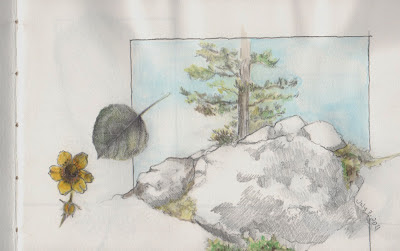An apple a day, watercolor on cold-pressed WC Paper, Cathy Cranmer
As you can see, a drawing a day keeps the blahs away, and this little gem is in full color. There're a lot of ways to "draw." You can use outline, also called contour, you can use grisaille, also known as massing in where you create form with tonal values, or you can use full color, working quickly, not fussing, getting busy!
This Week's Challenge
Sometimes, we get really tight when we start to draw. We believe we have to be "in control" and yet we know in our heart of hearts, we're pretty much not. That worries us! However, your eyes know how to talk to your brain, and your head knows how to talk to your hand. Here's a neat exercise to get out of your own way, that I have christened the "two-points tango."
Select a graphite pencil of medium tonal value. Select a colored pencil (yes, ANY color you want!) of about the same tonal value. Select a subject. Now, draw your subject using both points at the same time, like this:
Here's what happens. You're conscious mind will be so busy worrying about managing the 2 points that your hand, eyes and subconscious mind will just get on with the business of drawing your subject. With a little time, if you were drawing a neat little squash, you might end up with something like this:
Squash Study using Two-Point Tango method, Libby Kyer
That's pretty squash-like, with very little brain damage! Now, select two more colored pencils - an analogous green in a lighter tone, and a brown or gray worked well for this specimen. Spend some time fleshing out the specimen. Work on form a bit, highlights, more details, corrections and additions. Don't erase - remember, our motto is "No regrets!" We learn from every stroke we make! You'll might wind up with something like this, a little further into the process.
Squash Study building right on top of the sketch, Libby Kyer
And now, you're drawing! Color has slipped in. Details are crawling all over this thing. And form has ramped up. Could you continue? Absolutely. Why not give this method of loosening up, letting go and getting it right, a try! Send me your results, and when they're posted, we'll all learn from your shared efforts.











































